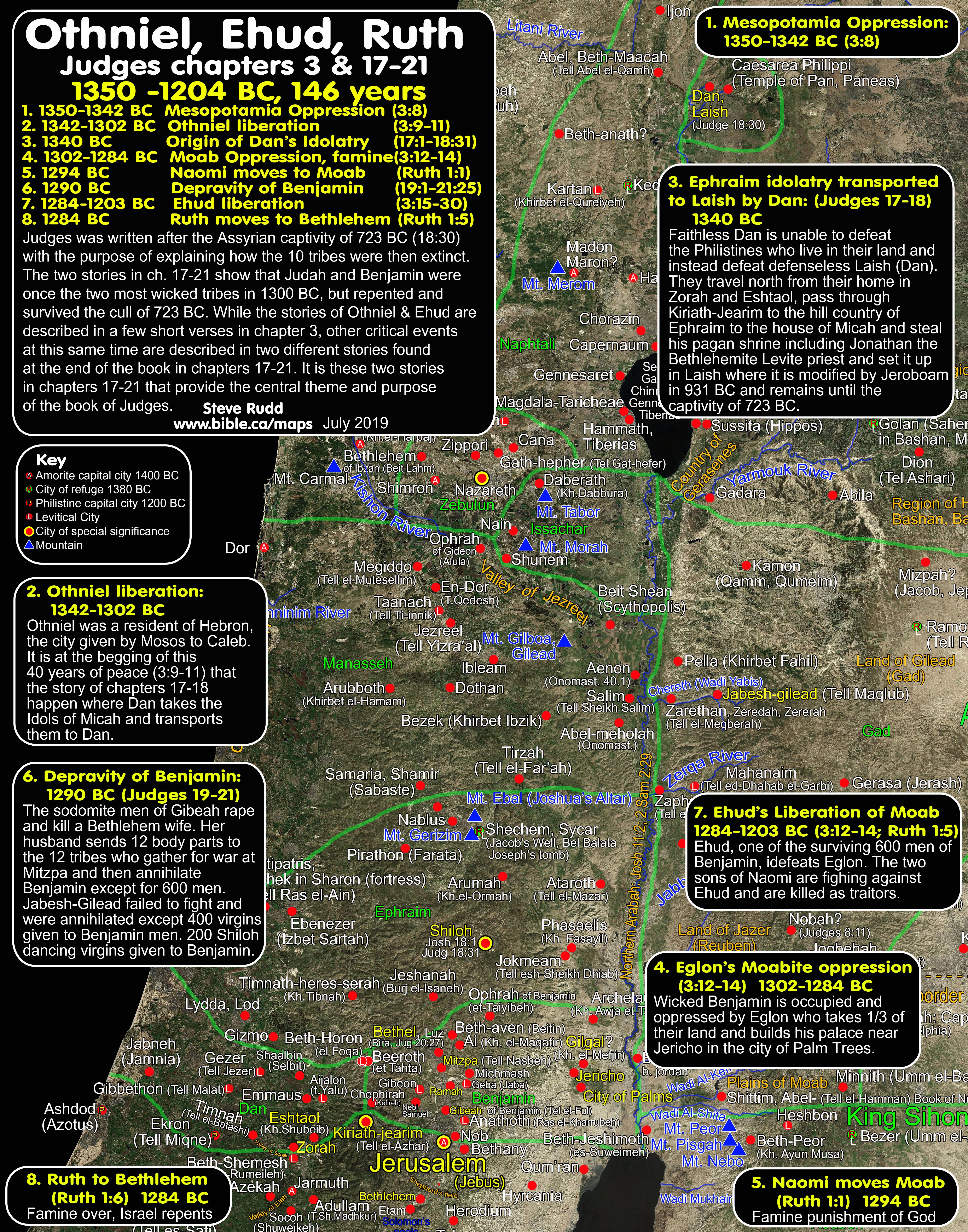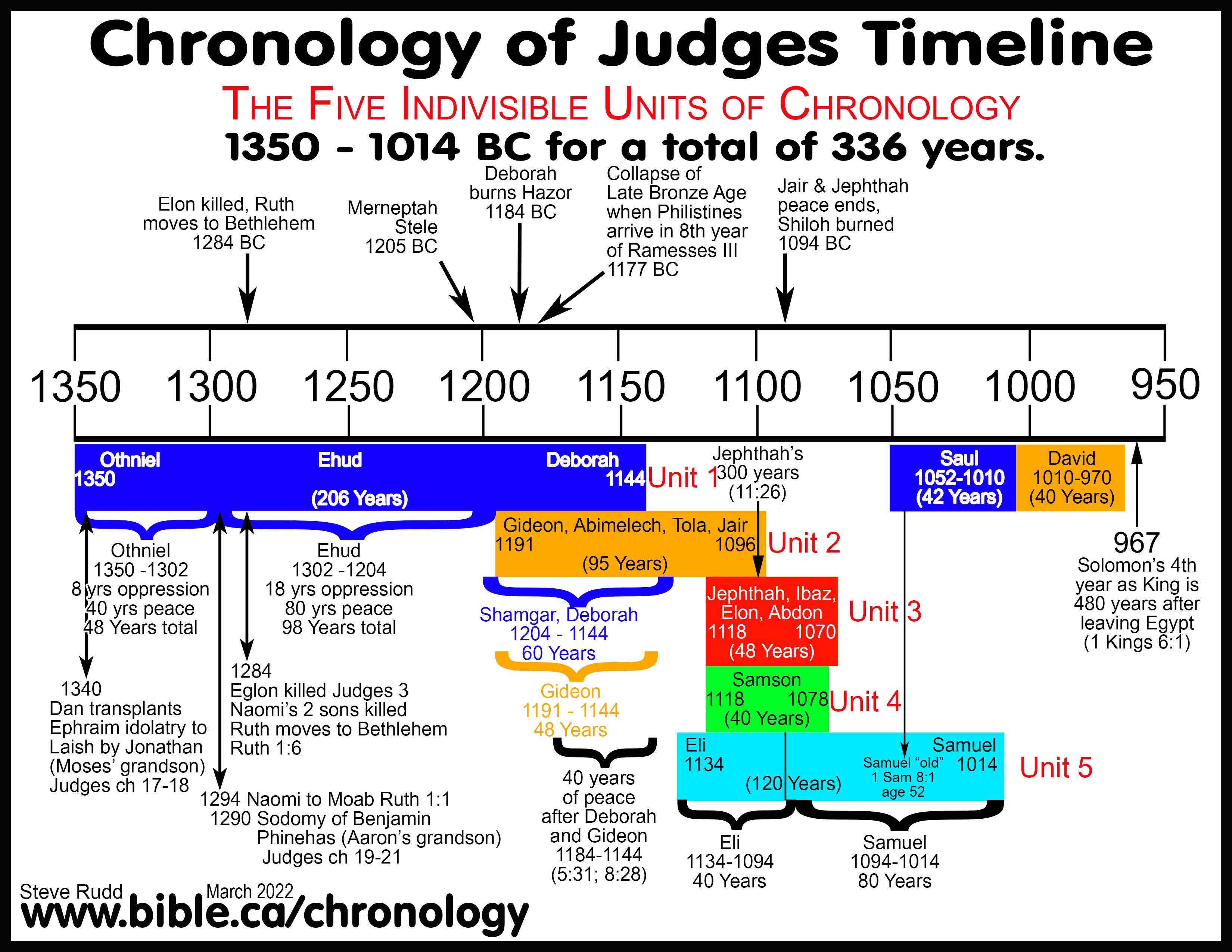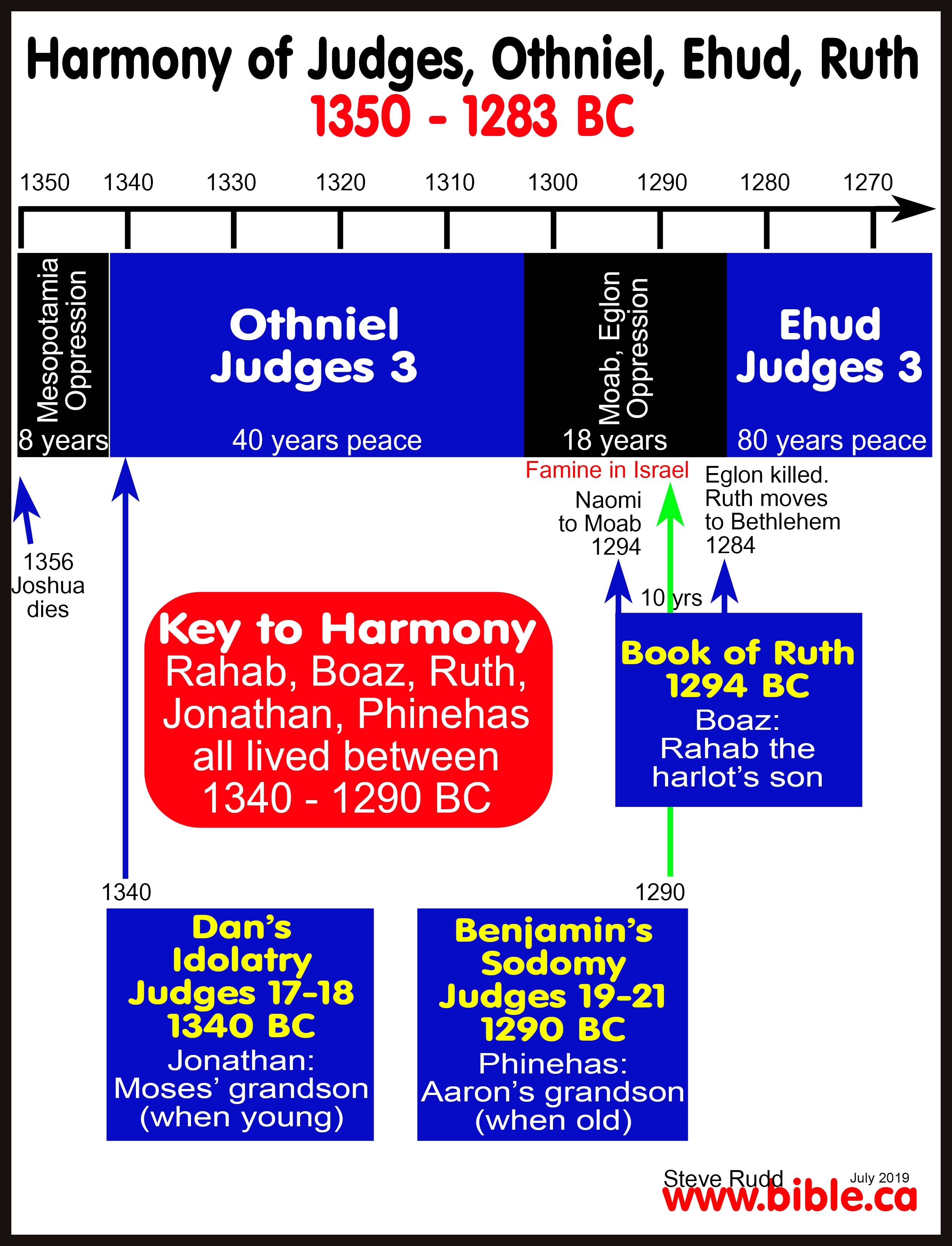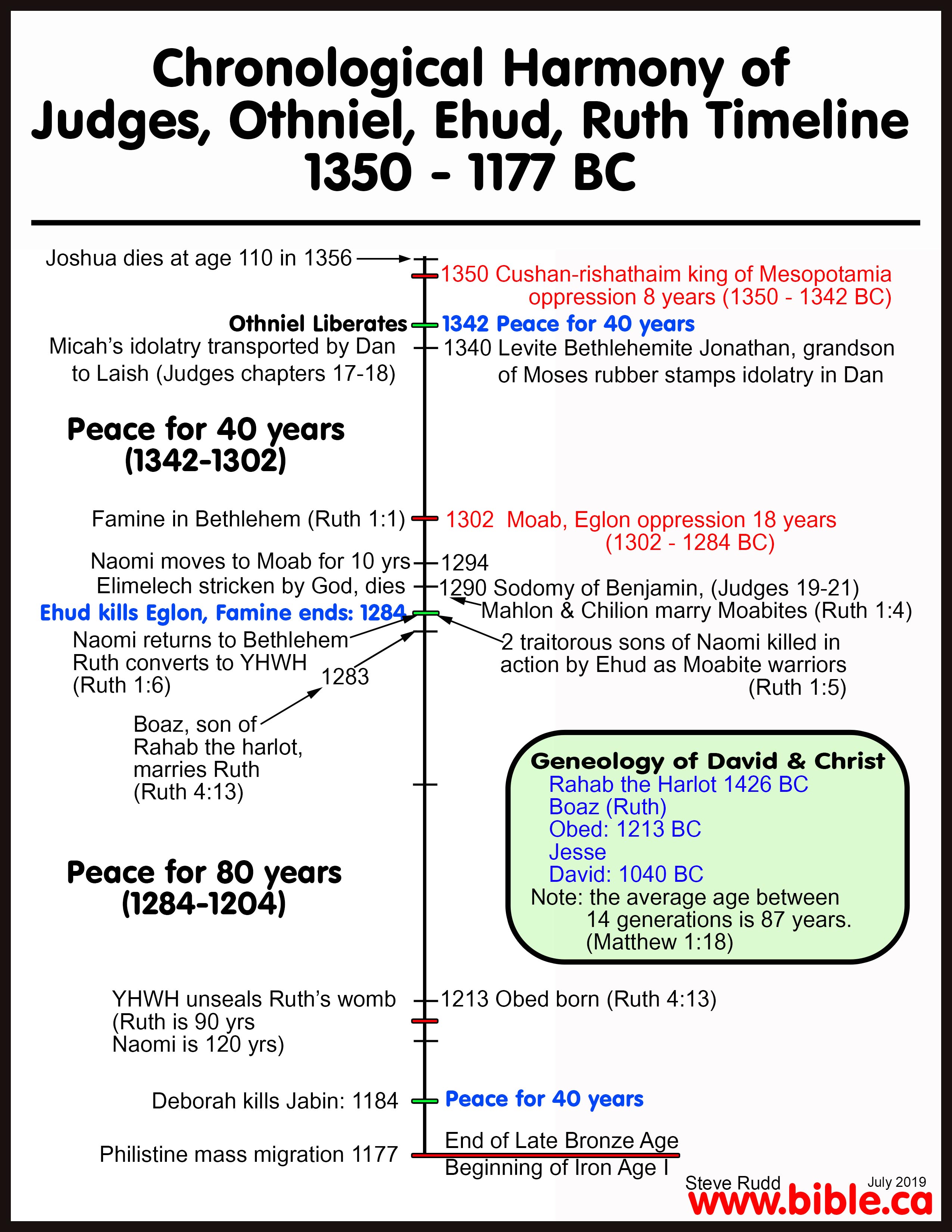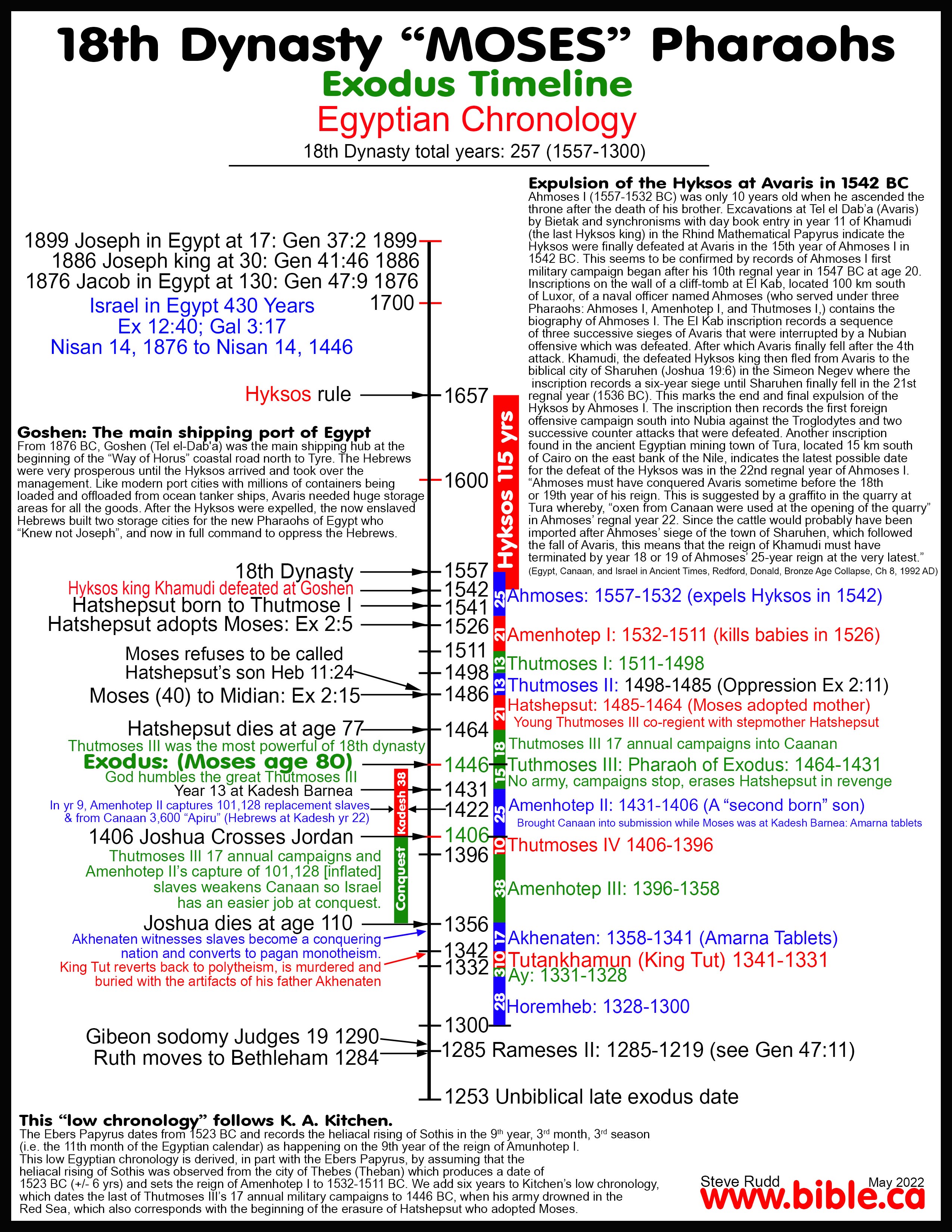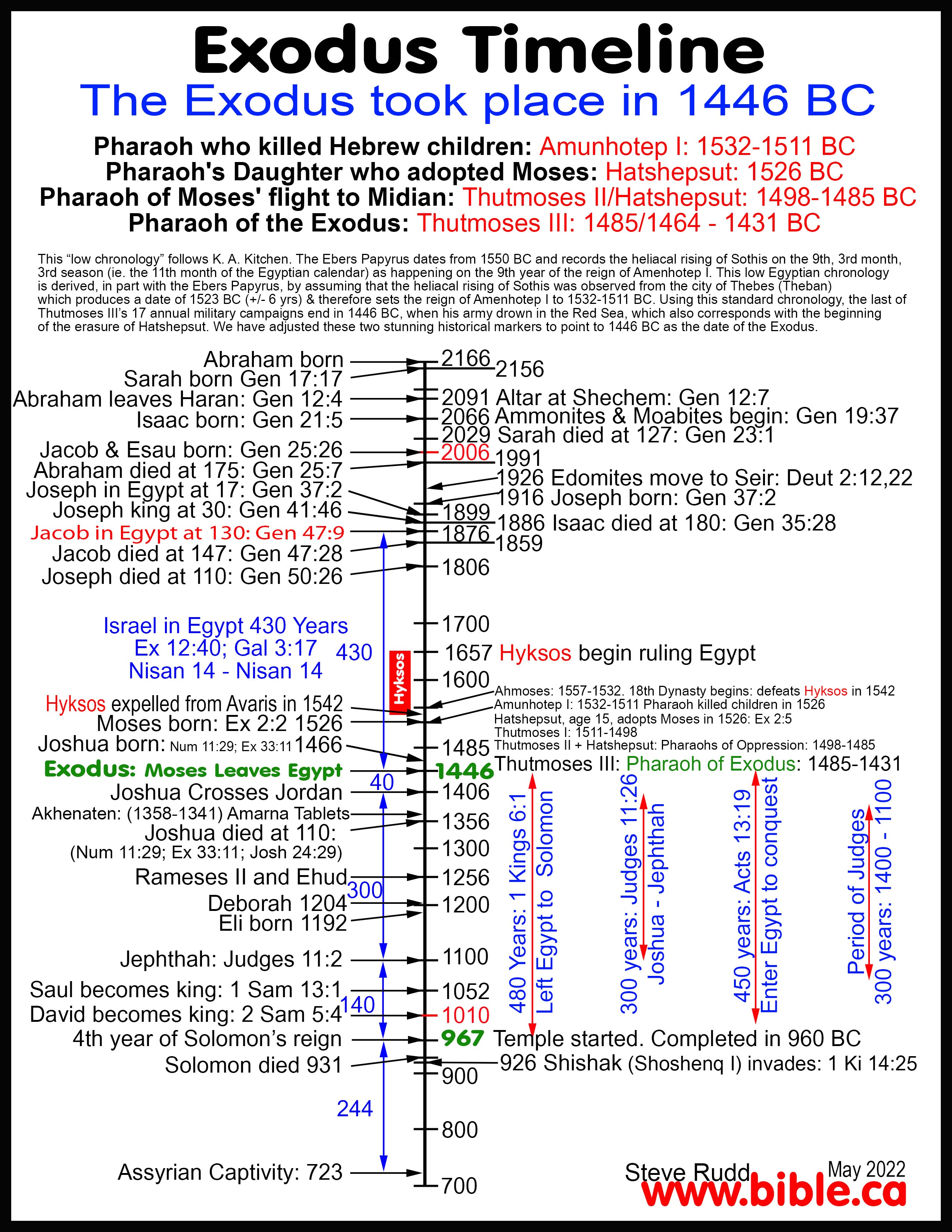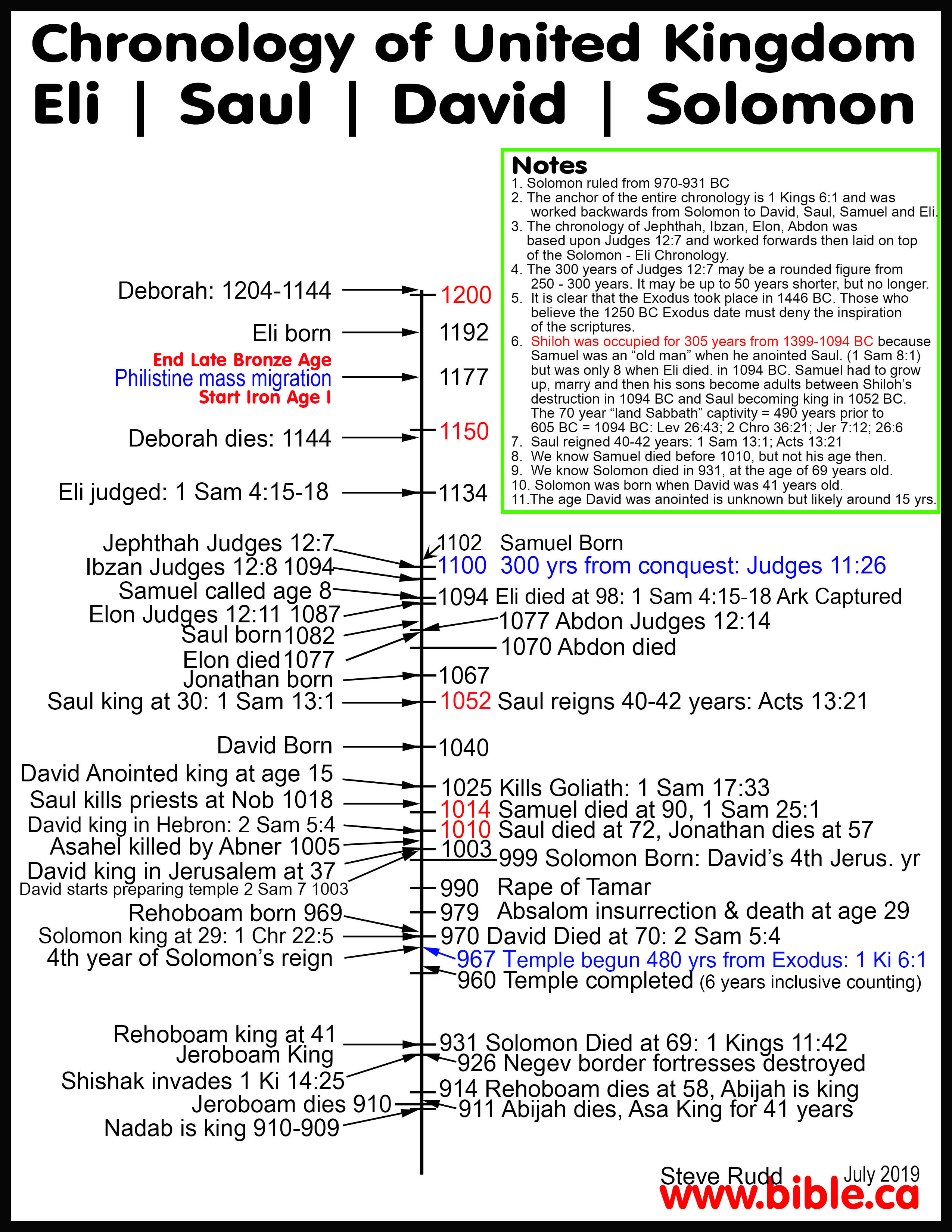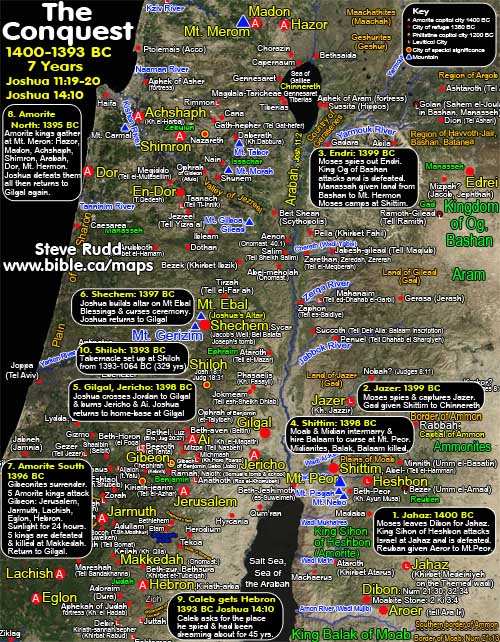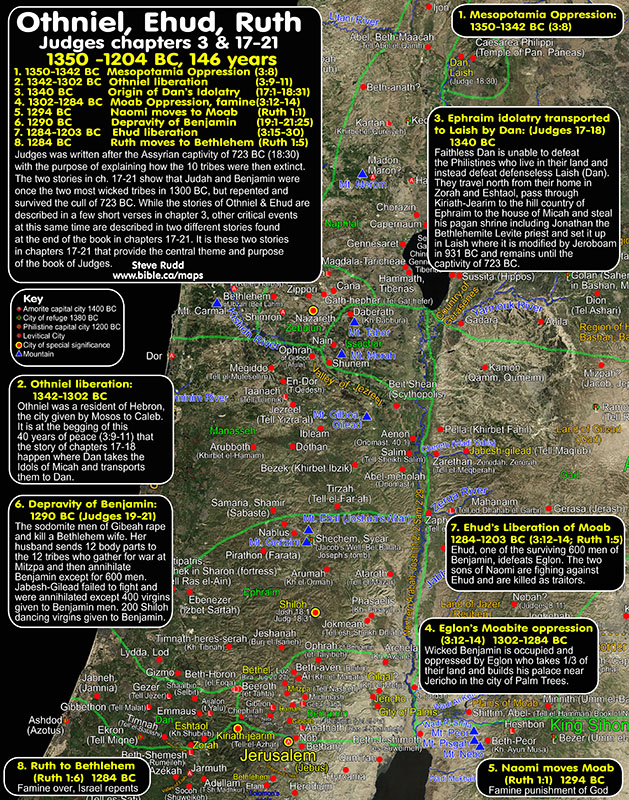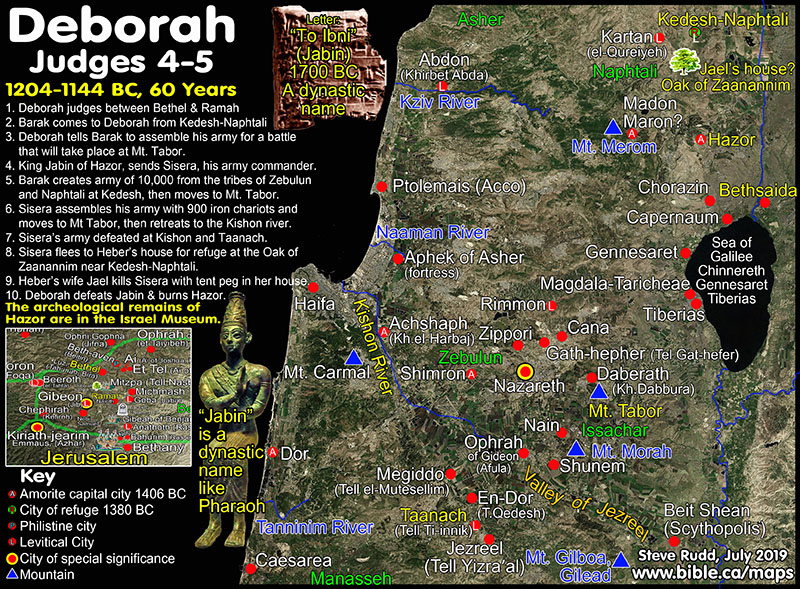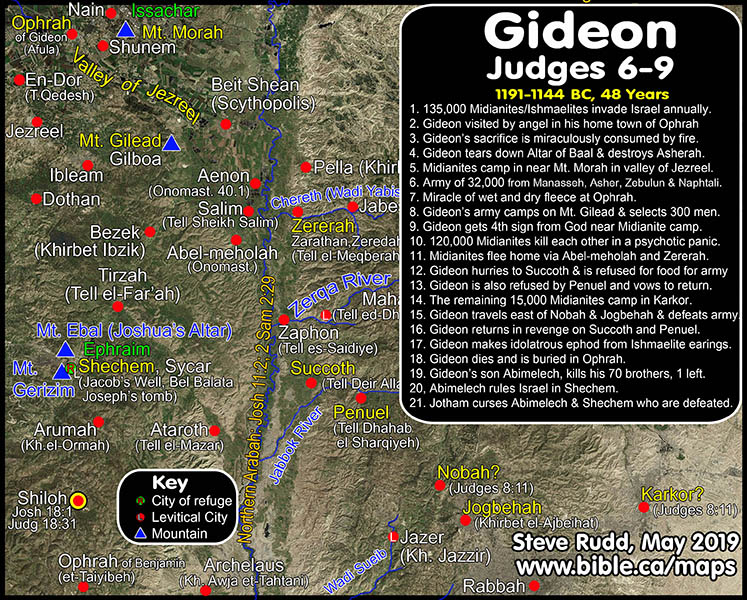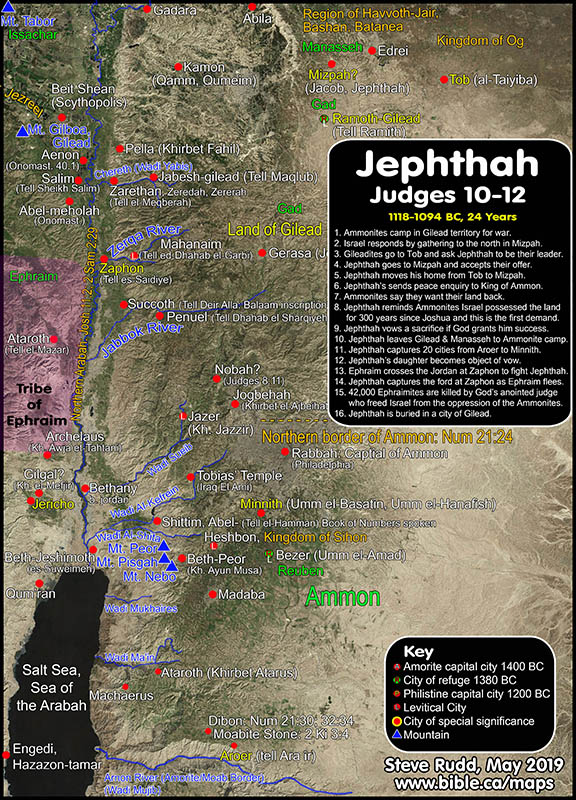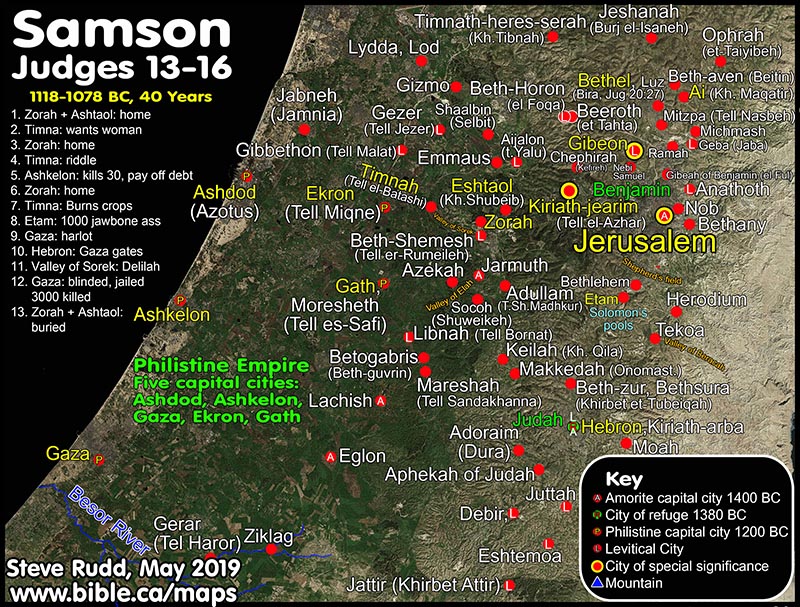Harmony
of Judges and Ruth:
Othneil, Ehud
Judges chapters 17-18
Judges chapter 19-21
The book of Ruth
1350 - 1204 BC
Timeline, maps, chronology, sermons of Othneil, Ehud, Ruth
Maps of
Othneil, Ehud, Ruth, Timeline of Othneil, Ehud, Ruth
Sermons and Outlines of Othneil, Ehud, Ruth
Archeological evidences of Othneil, Ehud, Ruth
|
|
|
|
|
|
|
|
|
Old Testament Chronology and Timelines |
||||||
|
Chronology of the Flood outline |
Chronology of Egypt outline |
Chronology of the Exodus outline |
Chronology of Judges outline |
Chronology of Ruth outline |
Chronology Eli-Solomon outline |
Chronology of Kings outline |
|
coming |
||||||
|
|
|
|
|
|
|
|
|
Judges Sermon Outlines |
||||||
|
Conquest |
Othniel, Ehud, Ruth |
Deborah |
Gideon |
Jephthah |
Samson |
Eli, Samuel, Saul, David |
|
1406-1399 |
1350-1204 |
1204-1144 |
1191-1144 |
1118-1094 |
1118-1078 |
1104-1004 |
|
Josh 1-15 |
Judges 3, 17-21, Ruth |
Judges 4-5 |
Judges 6-9 |
Judges 10-12 |
Judges 13-16 |
1 Samuel 1-31 |
|
Canaanites |
Mesopotamia, Edom |
Hazorites |
Ishmaelites, Midianites |
Ammonites |
Philistines |
Philistines, Ammonites, Amalekites |
|
|
|
|
|
|
|
|
Harmony of Judges and Ruth:
Harmony of Othneil, Ehud, Judges 17-18, Judges 19-21 and Ruth
Other related outlines:
1. Harmony of Othneil, Ehud, Judges 17-18, Judges 19-21 and Ruth
2. Book of Ruth: Ruth and Boaz lived in the time of Ehud: 1300 BC
3. Chronology of the book of Judges solved
Unlocking the book
of Judges and Ruth:
Othneil, Ehud, Exposition of Judges 17-21 and Ruth
· How Micah's idolatry was transplanted to Dan in 1340 BC which resulted in the extinction of the ten lost tribes in 722 BC: Judges 17-19
· How idolatrous Judah and depraved Benjamin escaped extinction in 722 BC: Judges 19-21
· How Naomi and Elimelech in the Book of Ruth lose their faith and their sons die fighting for Eglon, king of Moab by Ehud's army: Ruth and Boaz lived in the time of Ehud: 1300 BC
Introduction:
1. Unlocking the book of Judges: The book of Judges was written after the Assyrian captivity of 722 BC (18:30) with the express purpose of explaining how the 10 tribes were then extinct. The two stories in chapters 17-21 show that Judah and Benjamin were once the two most wicked tribes in 1300 BC, but repented and survived the cull of 722 BC. While the stories of Othneil and Ehud are described in a few short verses in chapter 3, other critical events at this same time are described in two different stories found at the end of the book in chapters 17-21. It these two stories that provide the central theme and purpose of the book of Judges.
a. "The sons of Dan set up for themselves the graven image; and Jonathan, the son of Gershom, the son of Moses, he and his sons were priests to the tribe of the Danites until the day of the captivity of the land." (Judges 18:30)
2. It is clear that the purpose of the entire book of judges is to provide an answer to the question of how 10 tribes of Israel went extinct after the 722 BC deportation.
a. "In the ninth year of Hoshea, the king of Assyria captured Samaria and carried Israel away into exile to Assyria, and settled them in Halah and Habor, on the river of Gozan, and in the cities of the Medes. Now this came about because the sons of Israel had sinned against the Lord their God, who had brought them up from the land of Egypt from under the hand of Pharaoh, king of Egypt, and they had feared other gods and walked in the customs of the nations whom the Lord had driven out before the sons of Israel, and in the customs of the kings of Israel which they had introduced." (2 Kings 17:6-8)
b. The condensed explanation of why 10 tribes went extinct is found in 2 Kings 17, but the long version with details is the book of Judges.
c. The last two stories in the book of Judges (ch 17-21) seem odd and out of place, but in fact are critical to understanding how ten tribes went extinct because of the Idolatry of Jeroboam in Bethel and most importantly at Dan.
i.
Judges 17-18 is the story that traces of origin of pagan idolatry in Dan
back to a Judean Levite named Jonathan, born in Bethlehem, a descendant of
Moses who became the Idolatrous priest of the Ephraimite family of Joash in the
hill country of Ephraim. The Danites were unable, due to lack of faith, to take
their land from the Philistines and as they journeyed north towards Laish (Dan)
they transported the entire pagan religious rite of Joash, including Jonathan,
to Dan. Therefore the story shows that Jeroboam's did not really invent a new
pagan golden calf religion, complete with its own priesthood etc, since Dan had
been a site of pagan idolatry for over 600 years earlier, from the time Dan
first occupied Laish (Dan). Therefore this first story explains the
Judean/Ephraimite origin of the idolatry that eventually led to the extinction
of 10 tribes in 722 BC. The reader must have experienced quite a shock to learn
that Idolatry of Jeroboam had its origin in not only a Levite priest born in
Bethlehem and a member of the tribe of Judah, but also the grandson of Moses
himself! Archeologically, you can see the actual altar
of Jeroboam in Dan today. However, is it the altar of Jeroboam or the
Altar of Micah Dan stole and set up at Dan?
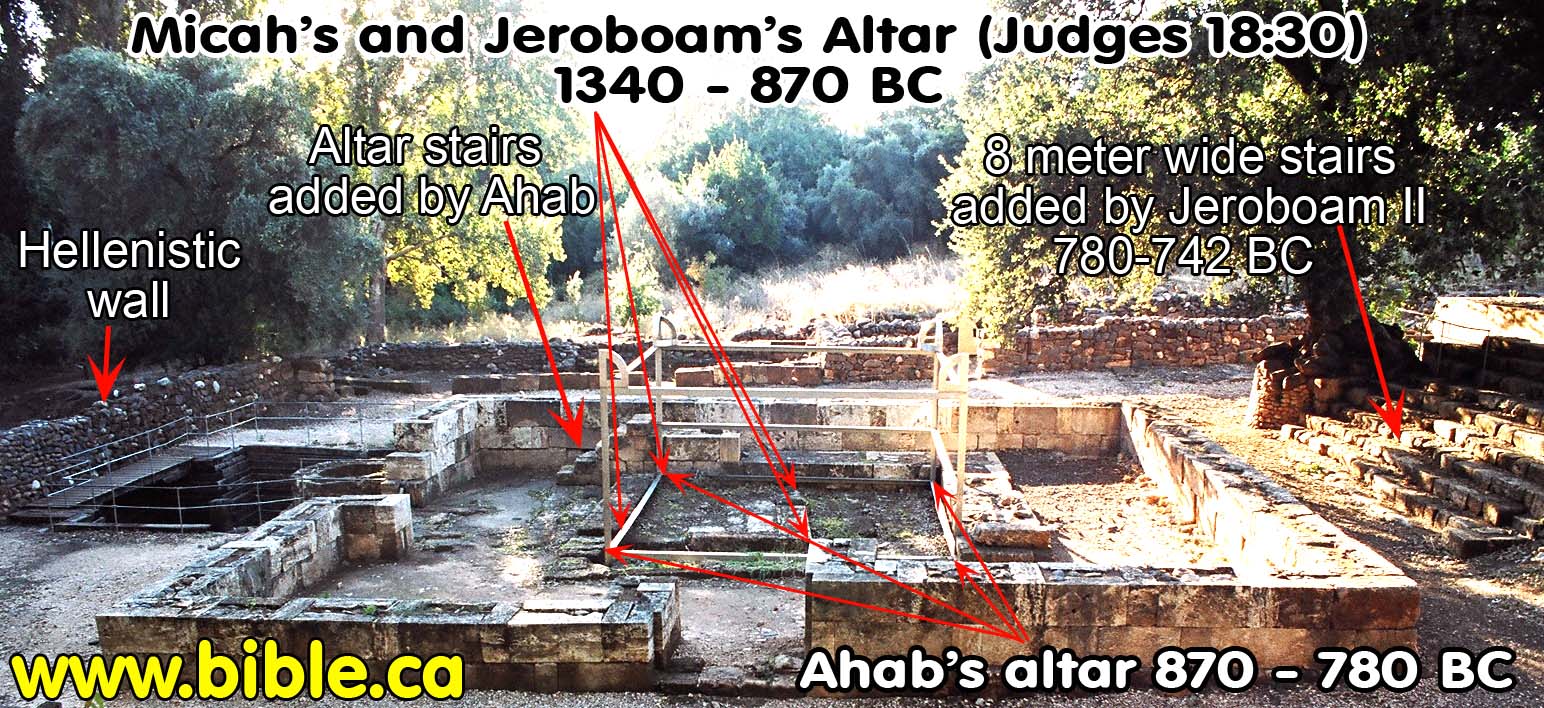
ii. Judges 19-21 is the story of how the two most wicked tribes (Judea and Benjamin) were chastened by God which resulted in their salvation and survival in after 722 BC.
iii. Great emphasis is placed in both stories that Bethlehemites played key roles in both stories. The reader in 720 BC, would immediately remember that David was born in Bethlehem.
3. The two most wicked tribes in 1340-1290 BC were Judah and Benjamin:
a. The wickedness of Judah is seen:
i. in the idolatry of Bethlehemite named Jonathan who moved to Dan and served as the first pagan levite priest.
ii. in the Bethlehemite harlot wife who escaped the Mosaic death sentence for adultery, only to die at the hands of the sodomizing men of Gibeah.
iii. in the in the 40,000 man, culling of Judah, who was chosen by God to be on the front line in the first il-fated defeat in the battle at Gibeah against Benjamin. Obviously God put Judah on the front line in order to kill a bunch of them off for their sin. This continues a long tradition started during the exodus, where God culls large numbers of sinners.
iv. in the story Ruth where the family of Naomi and Elimelech have lost their faith, leave their land in Bethlehem, move to the very nation that is oppressing Israel, marry their sons off to Moabite wives. We know that the events in the book of Ruth happened at precisely this same period. Elimelech dies at the hand of God for not joining the war against Benjamin (Jabesh-Gilead were annihilated for this) and their two sons were killed by Ehud's army as they fought for Eglon, King of Moab. (yes, this is speculation, but it fits perfect) See Book of Ruth: Ruth and Boaz lived in the time of Ehud and Judges chapters 18-21: 1300 BC.
b. The wickedness of Benjamin is seen in
i. the sodomy at Gibeah
ii. the fact that God culled them from 100,000 down to a mere 600 men alone shows just how evil the entire tribe was in God's eyes.
iii. the fact that Eglon, the king of Moab had taken a good chunk of their land away and was ruling at the "city of Palms" just outside Jericho. If you wanted to know where the sinners were in Israel, just look to that tribe that was most oppressed by a foreign king. Eglon set up his palace in small area of Benjamin.
c. The wickedness of Ephraim is seen in:
i. The fact that Micah, the Ephraimite, was the originator of the idolatry that was transported to Dan, modified by Jeroboam and the cause of the fall of 10 tribes in 722 BC
ii. About 100 years later in 1191 BC, Gideon's 70 sons are executed by their wicked half-Ephraimite step brother Abimelech who then makes himself the worthless "bramble" king in the Ephraimite town of Shechem with their full support. Here we have a case of the wicked executing the righteous.
iii. About 200 years later in 1118 BC, Jephthah liberates Ephraim from Philistine oppression and Ephraim's response is to attack Jephthah the anointed Judge of YHWH in war which resulted in the second major third major cull of 42,000 men of the tribe of Ephraim. Again, we have another example of the wicked attacking the righteous. This is the last time Ephraim is chronologically mentioned in the book of judges.
d. So pagan Judah who produces the harlot wife, is heavily culled by God in battle; and morally depraved sodomite Benjamin is eventually reduced to a mere 600 men.
4. Ironically, Israel in 1300 BC, asks God why a single tribe in Israel (Benjamin) is missing from the land, save 600 men, when the reader, 600 hundred years later is learning why 10 tribes are now missing after 722 BC. Further Irony is that the two most wicked tribes in Israel in 1300 BC of Judges 17-21 came to repentance and through the grace of God, were the only one's who escaped the 10 tribe culling of 722 BC at the hands of Shalmaneser, king of Assyria (2 Ki 17). What an inversion of events that Judah and Benjamin, the two villain tribes of 1300 BC were the only tribes to survive the 10 tribe extinction of 722 BC. This insight must have come as quite a shock to the reader of the book of Judges in 720 BC.
5. The stories of Gideon, Deborah and Samson etc. in Judges 1 -16, focuses on the Idolatry that led to foreign oppression. The first story of Judges 17-18 focuses on this idolatry but the second story of Judges 19-21 makes no mention of idolatry but focuses on the moral and social decay that led to foreign oppression at the hands of of Eglon, the king of Moab. The two stories paint a grim picture of the religious and moral decay present in 1300 BC. The reader in 720 BC would feel a déjà vu when they noticed this is what they had seen in the ten tribes that were just deported to Assyria a few years earlier.
6. In 1406 BC, Joshua spared the wicked men of Gibeon who surrendered to Joshua at Gilgal. They were allowed to live among the Benjaminites as slaves for almost 100 years, but may have been a contributing factor in the rapid moral decay 5 km east at Gibeah of Benjamin, as seen in the echo story of sodomy in Judges 19 where the narrative begins. Such debauchery may have pre-existed among the pagan Gibeonites when Joshua arrived in 1406 BC.
7. Both stories highlight Bethlehem, Judah and Ephraim.
a. In the first story, a Judean, Bethlehem-born priest moves to Ephraim where he sanctifies the Idolatry of Micah.
b. In the second story, an Ephraimite marries an adulteress Judean wife who was born in Bethlehem.
c. In the first story a Bethlehem born Levite priest travels to the hill country of Ephraim. In the second story an man living in the hill country of Ephraim travels to Bethlehem to retrieve his run away Judean adulteress wife.
A. Dating Judges 17-18 and 19-21:
1. Both stories revolve around men who lived at the same time.
a. The first story (ch 17-18) happens 20-50 years before the second story (ch 19-21).
a. In Judges 17-18, Jonathan, is the grandson of Moses and because he is described as a "young man" (18:3) it must have happened shortly after the death of Joshua, likely around 1340 BC.
b. Therefore, the story of Judges 17-18 happens at the beginning of the 40 year peace (after 8 years of oppression) when Othniel defeated Cushan-rishathaim king of Mesopotamia. (3:8) This makes logical sense because once the oppression was removed, the tribe of Dan would then feel confident to venture north in search of new land.
c. In Judges 19-21 the righteous high priest through whom Israel seeks pre-battle advice, Pinehas, the grandson of Aaron.
d. Aaron was the older brother of Moses by three years which means that the two key characters in the story lived at the same generational level and therefore at the same time.
|
Story |
Judges 17-18 |
Judges 19-21 |
Ruth |
|
Grandfather |
Moses |
Aaron |
|
|
Father |
Gershom |
Eleazar |
Rahab (mother) |
|
Character in story |
Jonathan (young man) |
Pinehas (old man) |
Boaz |
|
Judge contemporary |
After Othniel deliverance from king of Mesopatamia: Judges 3:9-11 |
During oppression by king of Moab, just prior to Ehud's deliverance. Judges 3:12-14 |
Ehud |
|
Date of story |
1340 BC |
1290 BC |
1294-1283 BC |
2. The story of Judges 17-18 happened after the death of Joshua (1350 BC) around 1540 BC and 50 years before Judges 19-21.
a. The story in Judges 17-18 revolves around Jonathan, the grandson of Moses:
b. "The sons of Dan set up for themselves the graven image; and Jonathan, the son of Gershom, the son of Moses, he and his sons were priests to the tribe of the Danites until the day of the captivity of the land." (Judges 18:30)
3. The second story of Judges 19-21 took place in the midst of the time of apostasy and oppression described in Judges 3:12-14 between 1302 BC - 1280 BC. A good guess would be about 1290 BC, which would give Benjamin ten years to rebuild under the occupation of Eglon, King of Moab. We know that the events in the book of Ruth happened at precisely this same period. See Book of Ruth: Ruth and Boaz lived in the time of Ehud and Judges chapters 18-21: 1300 BC
a. Phinehas was Aaron's grandson and began to serve as high priest in 1350 BC, which is the time when both Joshua and his father Eleazar died. Therefore Phinehas was an old man (120+ years? Aaron died at 123) in the story of Judges 19: "The sons of Israel inquired of the Lord (for the ark of the covenant of God was there in those days, and Phinehas the son of Eleazar, Aaron's son, stood before it to minister in those days), saying, "Shall I yet again go out to battle against the sons of my brother Benjamin, or shall I cease?" And the Lord said, "Go up, for tomorrow I will deliver them into your hand."" (Judges 20:27-28)
b. 1302 BC - 1280 BC: "Now the sons of Israel again did evil in the sight of the LORD. So the LORD strengthened Eglon the king of Moab against Israel, because they had done evil in the sight of the LORD. And he gathered to himself the sons of Ammon and Amalek; and he went and defeated Israel, and they possessed the city of the palm trees. The sons of Israel served Eglon the king of Moab eighteen years." (Judges 3:12-14)
i. Within 1302 BC - 1280 BC, likely 1290 BC, that the story of Judges 19-21 must be Chronologically placed.
i. While the details of the story seem bizarre and gruesome, the end result is Israel stepping back and taking a look at the bigger picture of how such Sodomy could exist and they eventually connected their larger apostasy with their oppression of Elgon, the Moabite king. So the offensive deviant sex, which echoed Sodom, actually brought Israel to repentance when they realized it was "time to get serious about God".
ii. "But when the sons of Israel cried to the LORD, the LORD raised up a deliverer for them, Ehud the son of Gera, the Benjamite, a left-handed man. And the sons of Israel sent tribute by him to Eglon the king of Moab." (Judges 3:15)
c. Ehud, the left handed Benjaminite delivered Israel in 1280 BC. What is amazing about this, is that God chose a Benjaminite to liberate Israel after wiping the tribe of Benjamin save 600 men!
d. This Ehud of Judges 3, must have been one of the 600 remnant who took refuge at the Rock of Rimmon after the tribe of Benjamin was almost annihilated. (20:47)
B. The "left handed Benjaminite" oxymoron:
1. It is ironic that "Benjamin" literally means "son of the right hand" yet the tribe of Benjamin are famous for left handed warriors!
2. The left hand connection: "From the cities on that day the sons of Benjamin were numbered, 26,000 men who draw the sword, besides the inhabitants of Gibeah who were numbered, 700 choice men. Out of all these people 700 choice men were left-handed; each one could sling a stone at a hair and not miss." (Judges 20:15-16)
a. Ehud: Benjamite Judge who delivered Israel from Moab at the conclusion of the defeat of Benjamin. Ehud was one of the 600 men who fled to the Rock of Rimmon and made peace with Israel and were given replacement wives from Jabesh-Gilead and Shiloh. Ehud delivered Israel shorty after the civil war where Benjamin was defeated.
b. Saul, the first king, is a Benjaminite! "Saul replied, "Am I not a Benjamite, of the smallest of the tribes of Israel, and my family the least of all the families of the tribe of Benjamin? Why then do you speak to me in this way?"" (1 Samuel 9:21)
c. David army: "Now these are the ones who came to David at Ziklag, while he was still restricted because of Saul the son of Kish; and they were among the mighty men who helped him in war. They were equipped with bows, using both the right hand and the left hand to sling stones and to shoot arrows from the bow; they were Saul's kinsmen from Benjamin." (1 Chronicles 12:1-2)
C. Exposition of Judges 17-18: How money a boy stole from his mother led to the destruction of ten tribes in 722 BC
1. 17:1-6: The story opens with a man named Micah in the hill country of Ephraim, confessing to his mother that he stole the 1100 pieces of silver that she had been looking for.
a. 1100 pieces of silver is a huge sum of money and is equal to what each of the five Philistine kings promised Delilah to betray Samson. (16:5) She was promised a total of 5500 pieces of silver.
b. She had uttered a curse and her son, confessed in order to escape the curse. His confession was motived out of fear of punishment, not morality and doing what is right.
c. The mother strangely rewards the delinquent son by giving him all the money to make an idol in the name of YHWH.
d. She overlooks the fact that her son is guilty of breaking several of the Ten Commandments including stealing and honouring your father and mother, coveting etc, then praises him in the name of YHWH and orders him to break the second commandment regarding graven images.
e. In the second commandment is contained a warning against CARVING or MOULDING and idol. "You shall not make for yourself an idol (literally carved image), or any likeness (literally poured from a form) of what is in heaven above or on the earth beneath or in the water under the earth." (Exodus 20:4)
f. The mother orders her son to explicitly break both elements of the second commandment: "I wholly dedicate the silver from my hand to the LORD for my son to make a GRAVEN image and a MOLTEN image; now therefore, I will return them to you." (Judges 17:3)
g. There are no bad kids, only bad parents so ultimately, the extinction of the ten lost tribes in 722 BC can be traced through Jeroboam in 924 BC back to the tribe of Dan in 1340 BC and ultimately back to this bad mother who orders her son to further break the ten commandments rather than discipline him.
h. Ephraim's contribution to the extinction of the ten tribes in 722BC, is Micah who turns stolen silver into an Idol, an Ephod and a shrine. Judah's contribution, as we will see, is the delusion that just because a Levite priest thinks all this idolatry is ok, that God will bless you.
2. 17:7-13 Enter Jonathan, the Bethlehemite priest, with blood lines in the tribe of Judah, who travels north to Ephraim in search of a job as a priest.
a. He accepts the offer to become the family Levite priest of Micah's idolatry.
b. Micah is now confident God will bless him when the Jonathan fails to criticize the idol but instead rubber stamps it.
c. Jonathan fails in his most basic duty as a priest of YHWH by presiding over a pagan shrine and it can all be traced back to his mother who orders him to make the shrine.
3. 18:1-31 The tribe of Dan seeks a larger territory
a. Through lack of faith in God, Dan is unable to defeat the Philistines who control 75% of their inheritance and they are forced to live in the hill country.
b. After Othniel delivers Israel from the oppression of king of Mesopatamia (Judges 3:9-11) the tribe of Dan decides to send scouts up north to find new land.
c. As the spied move north, they come to the house of Micah and recognize Jonathan, whom they knew when he lived in or near Bethlehem. They ask him for a blessing and they are granted success from YHWH.
d. The spies view Laish (city of Dan) and return with confidence that they can defeat the inhabitants.
e. As a portion of the tribe of Dan migrate north, they again come to the house of Micah and steal the silver idol, ephod and shrine and offer Jonathan the Levite, a promotion from being a priest of a single family to the top priest for the entire tribe. Money and pride motivate Jonathan, of course accepts.
f. While Micah feels robbed of his idolatrous religion of silver, it was in fact a blessing that this curse was removed from him so he could worship YHWH correctly.
4. The story concludes with the ominous observation that the pagan idolatry of Micah continued from the moment Dan arrived in Laish (Dan) to the time of the Assyrian captivity of 722 BC.
a. "The sons of Dan set up for themselves the graven image; and Jonathan, the son of Gershom, the son of Manasseh, he and his sons were priests to the tribe of the Danites until the day of the captivity of the land. So they set up for themselves Micah's graven image which he had made, all the time that the house of God was at Shiloh." (Judges 18:30-31)
b. All the while God's true religion was centered in Shiloh where the tabernacle of Moses and the Ark of the Covenant resided.
5. The reader in 700 BC would understand the origin of the idolatry of Jeroboam that led to the extinction of the ten lost tribes. An Ephraimite family creates a pagan shrine, and the Judean Levite grandson of Moses thinks this is all ok and becomes the priest of this family shrine. Then the tribe of Dan, whose lack of faith is measured by their failure to trust God to attack the well-defended warrior Philistines and instead chose the unprotected sitting duck, Laish, where they could act all brave. Dan transports this pagan shrine from Ephraim to Laish, where it continued, with a few modifications from Jeroboam in 924 BC, until captivity of 722 BC.
6. Now the reader in 720 BC knows the exact history of where the paganism had its origin: A bad mother, a thieving son, a material motivated priest and the faithless tribe of Dan.
7. This first story happened in 1340 BC.
D. The 40 years of peace of Othniel end with the 18 year Moabite oppression 1302-1284 BC
1. In 1302 BC, Eglon, king of Moab, begins to oppress Israel and moves his palace near Jericho, in the city of Palm trees. The city of palm trees was not so much a city, as a large forest of palm trees closely associated with Jericho on the outskirts of town.
2. Eglon takes over one third of Benjamin's territory next to the Jordan River.
3. Clearly this was a judgment of God against Benjamin because of their wickedness. Indeed, the next story in Judges 19-21 illustrates how the depravity of Benjamin was equal to that seen in Sodom and Gomorrah.
4. The story of Judges 19-21 happens in the middle of the Moabite oppression, likely in 1290 BC.
E. Exposition of Judges 19-21: How Judah and Benjamin escaped the captivity of 722 BC
1. In 1290 BC, in the middle of the oppression of Eglon, king of Moab (Judges 3) and about 50 years after the first story, a man is living in the hill country of Ephraim who has married a young girl who is a native of Bethlehem. She starts sleeping around on him and flees back to Jerusalem to her father's house in Bethlehem. The man goes to Bethlehem to retrieve his runaway adulteress bride and stays in her father's house for three days of feasting. In classic oriental hospitality, the man is coaxed to stay over five nights, even though he wants to leave immediately. The father likely used his daughters charms as an added incentive to stay the night.
2. Finally he leaves Bethlehem probably around noon and travels 8 km to reach a place (likely Nob) opposite Jebus (Jebusite occupied Jerusalem). Although the day is almost ended, he decides to travel on 12 more km to reach Gibeah of Benjamine in just after the sun had set. For those who question how far the Israelites travelled during the Exodus each day, here is a man who travels 20 Km (12 miles) in half a day. He goes to the central square of the city but nobody offers him shelter. He meets an old man who was returning from the field and is invited to stay in his house for the night.
3. In an exact repeat of the sodomy that Lot experienced, the men of Gibeah demand that the old man turn his male guest over to them for deviant sex practitioner sex. The reader must take note that the wickedness of Benjamin exceeded the pagan Jebusites. If only the man had stayed in the pagan city, he would have been safer.
4. The story that is told is written by the Holy Spirit in such a way so as to deliberately and closely follow the way the story of sodomy is told in Gen 19. In addition to the factual repeat of history, the exact identical Hebrew phrases between Gen 19 and Judges 19 we are stunned that both accounts use exactly 69 Hebrew words. While bible haters chortle that neither story is true and the Judges story copied from the Sodom story, in fact the opposite true. The Holy Spirit wanted to make sure that they understood that the wickedness of the tribe of Benjamin was equal to that in Sodom and Gomorrah. Here is a chart that shows how the Holy Spirit wanted to create another déjà vu moment of recall. The reader of Judges in 700 BC is shocked to comprehend that this same wicked Benjamin repented and survived the Assyrian captivity of 722 BC.
|
Genesis 19:4-8 |
Judges 19:22-24 |
|
4Before they lay down |
22 While they were celebrating, behold |
|
the men of the city |
the men of the city |
|
the men of Sodom |
certain worthless fellows |
|
Surrounded |
Surrounded |
|
the house both young and old all the people from every quarter. |
the house pounding the door |
|
5And they called |
and they spoke |
|
to Lot, |
to the owner of the house, the old man |
|
and said to him, |
saying, |
|
"Where are the men who came to you tonight? Bring them out to us, |
Bring out the man who came into your house, |
|
that we may have relations with them." |
that we may have relations with him." |
|
6 But Lot |
23 Then the man, the owner of the house, |
|
went out to them at the doorway and shut the door behind him. |
went out to them |
|
7And said, |
and said to them, |
|
"Please, my brothers, do not act wickedly. |
"No, my fellows, please do not act so wickedly do not act wickedly since this man has come into my house, do not commit this act of folly. |
|
8Now, behold, I have two daughters who have not had relations with man |
24 Here is my virgin daughter and his concubine |
|
Please, let me bring them out to you, |
Please let me bring them out that you |
|
and do to them whatever you like |
Please let me bring them out that you may ravish them and do to them whatever you wish |
|
only do nothing to these men inasmuch as they have come under the shelter of my roof. |
But do not commit such an act of folly against this man. |
|
69 Hebrew words in manuscript 125 English words in NASB |
69 Hebrew words in manuscript 126 English words in NASB |
5. The adulteress wife of the traveler is turned over to the men of Benjamin and she dies in the morning with her hands on the doorway. The man comes out in the morning and finds his wife laying there. Without showing any sympathy, he orders her to get up because he wants to leaven, but she is dead. He straps her to his donkey and when he gets home he dismembers her into twelve parts and sends the body parts to the twelve tribes. All tribes come running to avenge except the Transjordan town of Jabesh-Gilead who failed to heed the call to battle. After the defeat of Benjamin, the twelve tribes exterminate everyone in Jabesh-Gilead save 400 virgin women. It is interesting that 244 years later, Saul inside this same town of Jabesh-Gilead, deliberately cuts up a yoke of oxen into pieces and sends out from Jabesh-Gilead throughout Israel as a call to join him in battle. Even stranger, is the fact that Saul was a Benjaminite and his home base was the same town of Gibeah where the sodomy had happened 244 year earlier. The message of Saul was understood loud and clear: these twelve pieces of oxen are the warning that if you do not join me in battle, you will suffer the same fate of death that Jabesh-Gilead suffered when they failed to join the battle when the harlot was dismembered like the oxen. Here are the textual similarities that the Holy Spirit chose to disclose to the reader:
|
Judges 19:29-20:1 (1290 BC) |
1 Samuel 11:7 (1046 BC) |
|
When he entered his house, he took a knife and laid hold of his concubine |
He took a yoke of oxen |
|
and cut her in twelve pieces, limb by limb, |
and cut them in pieces |
|
and sent her throughout the territory of Israel |
and sent them throughout the territory of Israel by the hand of messengers, saying, "Whoever does not come out after Saul and after Samuel, so shall it be done to his oxen." |
|
All who saw it said, "Nothing like this has ever happened or been seen from the day when the sons of Israel came up from the land of Egypt to this day. |
Then the dread of the LORD fell on the people, |
|
Consider it, take counsel and speak up!" Then all the sons of Israel from Dan to Beersheba, including the land of Gilead, came out, and the congregation assembled as one man to the LORD at Mizpah. |
and they came out as one man |
6. All Israel is horrified at the sodomite debauchery of Gibeah of Benjamin and ask the tribal leaders of Benjamin to turn over the sinners for execution. The leaders are a corrupt as the sodomites, perhaps one of them and refuse.
7. The battle is 400,000 Israelite soldiers vs. 26,000 Benjamin soldiers plus an elite army of 700 left handed stone slingers who can hit a hair. The army of 400,000 assemble at Mitzpa just 4 km north west of the 26,000 member army at Gibeah.
8. Among these 700 left handed soldiers is Ehud, the judge of chapter 3 chosen by God to deliver Israel from the oppression of Eglon, King of Moab. Meanwhile Eglon is sitting in his palace 20 km due east watching as the army assembles and engages in civil war. This amassing of such a huge army must surely have been a cause of concern for Eglon. But he would not die for ten more years.
9. There are three battles, two defeats, then final victory. The initial defeats and the final chosen battle plan closely parallel the battle of Ai.
10. The Ark of the Covenant was used as a "lucky charm" to ensure success in battle three times: Jericho, the battle of Gibeah in the present story and the Philistine battle where the ark was captured when Eli was high priest at Shiloh. It is clear that for the third time, the Holy Spirit is creating a déjà vu moment by highlighting the defeat at Ai with the defeat at Gibeah.
11. It is now that are introduced to the old high priest, Pinehas who is the grandson of Aaron. He is asked to seek God's advice as to which tribe shall go up first. Judah is chosen to go up first which brings us back to the first verse of the book of Judges: "Now it came about after the death of Joshua that the sons of Israel inquired of the LORD, saying, "Who shall go up first for us against the Canaanites, to fight against them?" The LORD said, "Judah shall go up; behold, I have given the land into his hand."" (Judges 1:1-2) In 1406 BC Judah was the hero who went up first in battle and now, 110 years later Judah must have felt confident that they would succeed when Pinehas told Judah to be on the front line against Benjamin. But in the first battle, God sends Judah to the front line and 22,000 die in an obvious cull of wickedness out of the ranks of Israel. The reader in 720 BC cannot fail to connect the "sin of Achan" that caused defeat and the wickedness of Judah and their being placed on the front line for a slaughter of up to 22,000 men. In the second battle another 18,000 are killed out of sinful apostate Israel.
12. The true faith and reliance on God was lacking. Remember they are in a period of oppression under Moab. The first battle their confidence of winning seems to be the presence of the Ark of the Covenant, which normally rested in Shiloh, but was brought down for the battle as a lucky charm. There is no sacrificing or solemn assemblies or worship before the first battle begins. After the first defeat of 22,000, Israel weeps until sunset and then asks a second time if they should attack Gibeah again. However the weeping was more a loss of family than repentance to God for their sin. It is not until the second defeat of 18,000 more, that suddenly Israel connects the dots and realizes that they are themselves under the curse of God. They come to full repentance and for the first time, they weep, fast and sacrifice peace offerings to YHWH. Although there is no mention of putting off their foreign gods and idols, this clearly is what has now happened. Israel was defeated because of their sin and now they have fully dedicated their hearts to YHWH, they enquire a third time. Now God says go up again and they will now defeat Benjamin.
13. Parallels between the third battle at Gibeah and the Battle at Ai.
a. Both suffered initial defeat where worriers died because of sin in the camp.
b. Israel sets up the identical an ambush plan they had used to defeat Ai. After a few of them get killed, they retreat, drawing out the warriors in the city. Then the ambush team entered the city, destroyed everyone and set it on fire. The smoke was a signal for those retreating as bait, to turn back and attack the Benjamin army which was then defeated.
c. Both the soon to be defeated army of Ai and Gibeah flee due east, but are captured and defeated.
d. Immediately after defeating Ai, the Gibeonites surrender to Joshua at Gilgal. It is these same Gibeonites who may have been responsible for the moral decay and sodomy in the current city of Gibeah (5 km east of Gibeon) that is under attack. (Remember Gibeon and Gibeah are two different towns about 5 km apart.)
14. As the Benjamin arm flee east, they take refute at the Rock of Rimmon, (pomegranate rock) with is close by Gibeah about 2 km away. The actual site is unknown. These 600 men are trapped at the Rock of Rimmon for four months.
15. In a central and key verse in the entire book of Judges, Israel asks God why one of the twelve tribes are extinct. The reader immediately realizes that 600 years later, 10 tribes are now extinct at the hands of the Assyrians in 722 BC. This irony is underscored in the fact that the very tribes who wept to God that one tribe is extinct, are now all themselves extinct... except for Judah. The cared greatly for their neighbor at one time for then they cared about themselves.
16. To further amplify just how upset the ten tribes were about one tribe going extinct, the writer of the book of judges shows how much effort was put into saving Benjamin from total extinction, given there were still 600 men at the rock of Rimmon. An oath had been made to not give any women to Benjamin and the remaining tribes bend over backwards to find a way to get them some "incubators of the Benjamin state" so they could survive and recover.
17. They discover that no one from Jabesh-Gilead came to help in the battle. This was a grave offence, considering the stern warning Moses had given all the Transjordan tribes that they must cross the Jordan to help their brothers take the land under Joshua 110 years earlier. Later under Deborah, the Transjordan tribes again breeched their promise to Moses and failed to join her battle. (5:16-17) Now they were doubly justified in wiping out this traitorous city, and as a clever bonus, they would spare 400 virgin women and give them to the men at the Rock of Rimmon as a gesture of peace.
18. But there were still 200 men without wives to produce offspring, so a second clever plot was hatched at the annual feast celebration at Shiloh. Most likely this would have been a major required religious feast like Passover, Pentecost or feast of the first fruits of harvest. As an act of religious dedication, young virgins would dance at these festivals in worship to God. The remaining 200 men of Benjamin would hide in the vineyards and grab the virgin of their choice and haul her off to become his baby maker in Benjamin.
19. The story highlights the disregard of women of the time. First the choice of giving a women to the sodomites, whereas Eph 5:22-32 teaches the opposite that the man should die to protect his wife, not the other way around. Also the 400 virgin women of Jabesh-Gilead were ripped from their families, towns and culture and given, without consideration of their own desires, to be baby factories for the once evil Benjaminites. Yet this was a blessing because their future, once destruction, is not bright as one of the tribes that would survive the 722 BC extinction. Then the lack of consideration for the 200 women at Shiloh who were kidnapped and made Benjamin wives.
20. The religion of children is determined by the mother and the commitment to that religion is determined by the father. But to this point, the Benjaminites had made poor choices in their religion. What a blessing in disguise were these 200 highly spiritual virgins who, instead of staying home and partying with their friends, chose out of dedication to YHWH to travel to Shiloh and worship God front and center in religious dance.
21. It may well be that the survival of Benjamin depended on the repentance of the 400 virgins of Jabesh-Gilead, who understood in time why their wicked town was destroyed and the positive role models of the 200 virgins of Shiloh. So while the all the women were abused in this story, it was the women who are the real heroes in the eyes of the readers in 720 BC.
22. Seven years later, Ehud, who married one of these 600 women, defeats the king of Moah as per the story in Judges 3.
F. Exposition of Judges 3: Ehud kills Eglon, King of Moab:
1. In 1283 AD, Ehud, the left-handed warrior who once sought refuge at the rock of Rimmon, kills the Eglon, king of Moab.
2. Ehud had been chosen by the rest of Israel to send their tribute tax to Eglon. This was logical since Eglon occupied Benjaminite land and the defeated 600 warriors sought ways of bringing peace with the rest of Israel. There may have been a risk of death, injury, torture or imprisonment as the one who brings the taxes to an oppressor king, so why risk one of the good boys? Send one of these wicked Benjamites and let them suffer if they must!
3. It is interesting that Ehud came and said, "I have a secret message for you" to the king. We cannot know what that message was, but the king knew Ehud was one of the 600 men who survived the slaughter of the tribe of Benjamin. Perhaps Eglon assumed that this small band of men wanted to form some kind of alliance and in order to get on the kings good side, they were tipping off the king about an Israeli plan to defeat him. Speculation yes, but the strange events of the civil war that Eglon witnessed on the sidelines coupled with a secret message from the defeated victim tribe must be taken into consideration.
G. The book of Ruth is placed at this same period:
1. We know that the events in the book of Ruth happened at precisely this same period. See Book of Ruth:
2. Ruth and Boaz lived in the time of Ehud and Judges chapters 18-21: 1300 BC.
3. It seems likely that Naomi's two sons had lost their faith to the point of not only marrying Moabite women, but actually joining Eglon's army to fight against Israel. They were both killed at the same time by Ehud's army as traitors! See Book of Ruth:
Conclusion:
1. The book of Judges was written some time after the 722 Assyrian captivity as a way to explain why then tribes are extinct and warn about future apostasy. Even the book of Judges failed because in 586 BC Judah and Benjamin went into Babylonian Captivity for 70 years for the exact same reasons. When Judah returned, they never again worshipped idols.
2. Christians familiar with this history connect Judah being selected for the battle front and defeated and Jesus Christ as the victorious lion of the tribe of Judah in Rev 5 who "went to the front line" against the enemy and defeated the devil because of his righteousness.
3. Rameses II made a peace treaty with the king of the Hittites about 1250 BC. This is directly in the middle of the 80 years of peace by Ehud which lasted for at least 25 years. This is very powerful circumstantial proof that Israel was already in the land and supports an exodus date of 1446 BC. Thutmose III was the pharaoh of the exodus, certainly not Rameses II.
4. The date for the razing of Hatzor is about 1200 BC, not 1229 BC as often suggested. 1290 BC is just too early.
5. The central point of the book of Judges is that history repeats itself and that the wicked can repent and the righteous can fall.
a. While 2 Kings 17 explains that it was the idolatry of Jeroboam who caused the 10 tribes to go extinct, the book of Judges traces this idolatry back to a bad idolatrous mother, a thieving son and a wicked materialistic Judean Levite priest.
b. As bad as the ten lost tribes were, their sin was nowhere near as extreme sodomite level of sin in Benjamin as illustrated in the book of Judges.
c. That was in 1300 BC, yet here we are in 720 BC. The Assyrians have just deported the 10 most righteous tribes of 1300 BC and the two most wicked tribes have repented and survived deportation.
6. Take note that God wiped out the tribe of Benjamin, save 600 men in 1290 BC, then 6 years later (1284 BC) God choses a Benjaminite (Ehud) to be the savior and judge and king of Israel! This is a testament to the amazing grace and forgiveness of God who never keeps grudges!
7. Judah and Benjamin were the two most wicked tribes of 1300 BC but they repented and not only survived the cull of 722 BC, but survived the Babylonian captivity of 586 BC, even right down to the church age. Judah produced Jesus Christ who is the savior of the world and Benjamin produced Ehud and the apostle Paul who wrote half the New Testament.
8. The reader of Judges in 720 BC now understands why Ephraim is centered out for special attention in the book. Ephraim was the prideful spoiled rich kid of the family since they enjoyed the power of the "House of Joseph" until it was replaced as the center of power by the "House of David". It was Ephraim that produced Joshua and housed the tabernacle of Moses for 329 years at Shiloh. Yet in spite of all these spiritual advantages to excel for YHWH, Micah, the Ephraimite, invented the idolatry that Jeroboam inherited and modified at Dan 600 years later. Twice in the book of Judges Ephraim fails to join the liberators in battle. Even worse, instead Ephraim twice attacked God's righteous anointed servants (Gideon's family and Jephthah).
9. The two stories of Judges 17-21 highlight the tribes of Ephraim and Dan as the two bad boys of the family. In a stunning confirmation of the purpose and theme of the book of judges as described herein, notice that in the list of the twelve tribes in Rev 7 that neither Dan nor Ephraim are included in the list. Apparently both the tribes of Dan and Ephraim had committed the unforgivable sin of paganism and were primarily responsible for leading their brothers away from YHWH. In the place of Dan and Ephraim are listed Levi and Joseph to make up the twelve.
10. Jacob's blessing of Dan says it all: "Dan shall judge (test) his people (through their idolatry), as one of the tribes of Israel. Dan shall be a serpent in the way, a horned snake in the path, That bites the horse's heels, So that his rider falls backward (in 722 BC). For Your salvation I wait, O Lord." (Genesis 49:16-18)
11. The river "Jordan" means "down from Dan" in Hebrew. Obviously the Jordan was not called "the Jordan" until after the tribe of Dan moved north after 1350 BC. This is one of several clear examples of where the writer of the book of Genesis applies later names to earlier events. This makes it rather obvious that Moses did not write the book of Genesis. But the Devil also had a victory with the river Jordan. The pure source (headwater) of the Jordan is near Laish (Dan) and it was polluted with paganism and forever associated with the pagan an evil tribe of Dan. Just as dirty water poisons a population, so too the dirty paganism of Dan polluted 10 tribes to their spiritual death.
Other related events that happened at the same time as Judges 19-21:
1. Book of Ruth: Ruth and Boaz lived in the time of Ehud: 1300 BC
2. Harmony of Othneil, Ehud, Judges 17-18, Judges 19-21 and Ruth
3. Chronology of the book of Judges solved
By Steve Rudd: Contact the author for comments, input or corrections.
